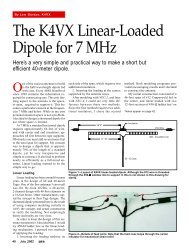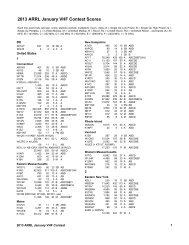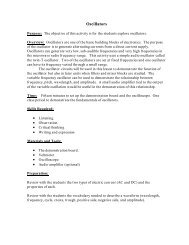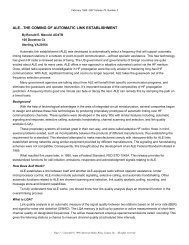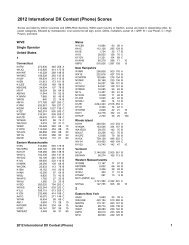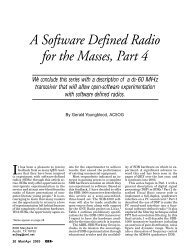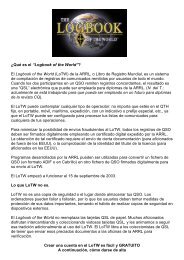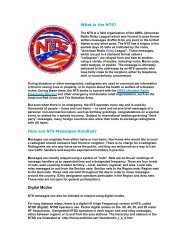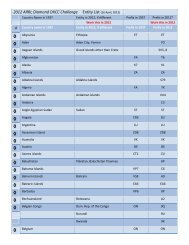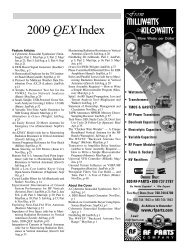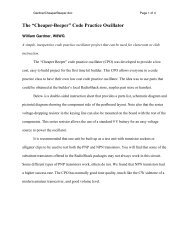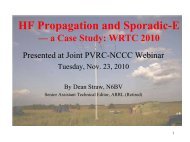Radio Waves and the Ionosphere - ARRL
Radio Waves and the Ionosphere - ARRL
Radio Waves and the Ionosphere - ARRL
Create successful ePaper yourself
Turn your PDF publications into a flip-book with our unique Google optimized e-Paper software.
By Ian Poole, G3YWX<br />
<strong>Radio</strong> <strong>Waves</strong> <strong>and</strong> <strong>the</strong> <strong>Ionosphere</strong><br />
Although hams are required to have a passing familiarity with <strong>the</strong> physics of <strong>the</strong><br />
ionosphere, a more intimate underst<strong>and</strong>ing can make or break your enjoyment of <strong>the</strong><br />
hobby. This primer will fill in some of <strong>the</strong> blanks <strong>and</strong> start you on a fascinating journey.<br />
adio propagation via <strong>the</strong> ionosphere is a fascinating <strong>and</strong><br />
R important means of long-distance radio communication.<br />
Thous<strong>and</strong>s of hams <strong>and</strong> commercial operators use <strong>the</strong><br />
ionosphere every day to make contacts over vast distances.<br />
To effectively use <strong>the</strong>se propagation modes to <strong>the</strong>ir fullest,<br />
however, we must underst<strong>and</strong> <strong>the</strong> physics behind <strong>the</strong> magic. Knowing<br />
when to listen, <strong>the</strong> best frequencies to use <strong>and</strong> where signals<br />
might come from enable experienced DXers to work stations when<br />
less-experienced operators come up short. In fact, knowledge of<br />
propagation <strong>and</strong> a “feel” for conditions <strong>and</strong> what each b<strong>and</strong> might<br />
produce are valuable commodities for any radio operator.<br />
The Atmosphere<br />
Before we look at how signals are reflected by <strong>the</strong> ionosphere<br />
we must see where <strong>the</strong>se reflections take place <strong>and</strong> how <strong>the</strong> reflecting<br />
areas are formed. The atmosphere can be split into a<br />
variety of different layers according to <strong>the</strong>ir properties. The most<br />
commonly used names are shown in Figure 1. Here we can see<br />
that <strong>the</strong> troposphere is <strong>the</strong> part of <strong>the</strong> atmosphere closest to <strong>the</strong><br />
ground, extending to a height of about 10 km. At altitudes between<br />
10 <strong>and</strong> 50 km we find <strong>the</strong> stratosphere, which contains <strong>the</strong><br />
famous ozone layer at a height of about 20 km.<br />
For shortwave communication <strong>the</strong> ionosphere is <strong>the</strong> most im-<br />
From November 1999 QST © <strong>ARRL</strong><br />
portant, although <strong>the</strong> troposphere plays a key role in VHF <strong>and</strong><br />
UHF communication. The ionosphere crosses several meteorological<br />
layers <strong>and</strong> extends from about 50 to 650 km.<br />
The <strong>Ionosphere</strong><br />
The ionosphere is so named because it is a region in <strong>the</strong> atmosphere<br />
where ions exist. In most areas of <strong>the</strong> atmosphere molecules<br />
are in a combined state <strong>and</strong> remain electrically neutral. In <strong>the</strong><br />
ionosphere, however, solar radiation (mainly ultraviolet light) is so<br />
intense that when it strikes gas molecules <strong>the</strong>y split—ionize—<strong>and</strong><br />
an electron is set free. What remains is a positive ion (a molecule<br />
that is “missing” an electron) <strong>and</strong> a free electron. Although ions<br />
give <strong>the</strong>ir name to <strong>the</strong> region, free electrons actually affect radio<br />
waves. The number of electrons starts to increase at an altitude of<br />
about 30 km, but <strong>the</strong> electron density isn’t sufficient to affect radio<br />
waves until about 60 km.<br />
We often think of <strong>the</strong> ionosphere as having a number of distinct<br />
layers. This is convenient for many explanations, but it’s not entirely<br />
accurate as <strong>the</strong> entire ionosphere contains ionized molecules<br />
(<strong>and</strong> free electrons). Instead, <strong>the</strong> layers are best thought of as peaks<br />
in ionization levels.<br />
To quickly identify <strong>the</strong> layers, peaks or regions, we refer to<br />
<strong>the</strong>m by <strong>the</strong> letters D, E <strong>and</strong> F. (There is a C layer, but its level of<br />
ionization is so low that it has no effect on radio waves.)<br />
Layers<br />
The D layer is <strong>the</strong> lowest, at altitudes between 50 <strong>and</strong> 80 km.<br />
It is present during <strong>the</strong> day when radiation is beaming in from <strong>the</strong><br />
sun. Because <strong>the</strong> density of <strong>the</strong> air is still high at this altitude,<br />
however, ions <strong>and</strong> electrons recombine relatively quickly. After<br />
Figure 1—Areas of <strong>the</strong> atmosphere. Figure 2—Typical electron distribution (day <strong>and</strong> night).
sunset, when solar radiation is blocked by <strong>the</strong> Earth, electron<br />
levels fall quickly <strong>and</strong> <strong>the</strong> D layer effectively disappears.<br />
Above <strong>the</strong> D layer, <strong>the</strong> next ionization level is called <strong>the</strong> E<br />
layer. It can be found at altitudes between 100 <strong>and</strong> 125 km. Because<br />
electrons <strong>and</strong> ions recombine relatively quickly here, ionization<br />
levels drop quickly after sunset. Although a small amount of residual<br />
ionization persists, <strong>the</strong> E layer virtually disappears at night.<br />
The most important layer for long-distance communication is<br />
<strong>the</strong> F layer. During <strong>the</strong> day it often splits into sub-layers we call<br />
F1 <strong>and</strong> F2, as shown in Figure 4. (At night <strong>the</strong> two layers merge<br />
back into a single F layer.) F-layer altitudes vary considerably<br />
<strong>and</strong> depend on <strong>the</strong> time of day, <strong>the</strong> season <strong>and</strong> <strong>the</strong> state of <strong>the</strong> sun.<br />
In <strong>the</strong> summer, <strong>the</strong> F1 layer may be at 300 km, with <strong>the</strong> F2 layer<br />
at 400 km or more. In <strong>the</strong> winter, <strong>the</strong>se figures may be about<br />
300 km <strong>and</strong> 200 km, respectively. At night, <strong>the</strong> F layer is generally<br />
around 250 to 300 km. These figures vary considerably, however,<br />
so consider <strong>the</strong>m as approximates.<br />
As with <strong>the</strong> D <strong>and</strong> E layers, ionization levels in <strong>the</strong> F layer decrease<br />
at night. The rate of recombination is much slower, however,<br />
because <strong>the</strong> layer is higher <strong>and</strong> air density is much lower. Because <strong>the</strong><br />
ionization remains overnight, it can still affect radio signals<br />
The Sun <strong>and</strong> <strong>the</strong> <strong>Ionosphere</strong><br />
It’s not surprising that solar variations affect <strong>the</strong> ionosphere.<br />
One major factor is <strong>the</strong> number of visible sunspots. The spots<br />
appear on <strong>the</strong> surface of <strong>the</strong> sun as dark (relatively speaking)<br />
areas that can be seen when an image of <strong>the</strong> sun is projected onto<br />
a screen or a piece of paper. Sunspots affect <strong>the</strong> ionosphere<br />
because <strong>the</strong> areas around <strong>the</strong> spots emit greater amounts of <strong>the</strong><br />
ultraviolet radiation—<strong>the</strong> main cause of ionization.<br />
Note: Never look directly at <strong>the</strong> sun, even through darkened<br />
glasses. Doing so can permanently damage your sight.<br />
The number of spots varies, roughly conforming to an 11-year<br />
period. This means that ionospheric conditions—<strong>and</strong> radio propagation—vary<br />
in sync with this cycle. At <strong>the</strong> low point of <strong>the</strong> cycle,<br />
HF b<strong>and</strong>s above 20 MHz or so may not support ionospheric<br />
propagation. At or near <strong>the</strong> 11-year peak, frequencies at 50 MHz<br />
<strong>and</strong> higher may be effective.<br />
Ground <strong>and</strong> Sky <strong>Waves</strong><br />
Signals in <strong>the</strong> medium <strong>and</strong> shortwave b<strong>and</strong>s travel by two<br />
basic means: ground waves <strong>and</strong> sky waves.<br />
Ground waves occur as <strong>the</strong> signal spreads out from <strong>the</strong> transmitter<br />
in all directions. Instead of traveling in a straight line (<strong>and</strong><br />
not being heard beyond <strong>the</strong> visual horizon), radio signal tends to<br />
follow <strong>the</strong> curvature of <strong>the</strong> Earth. This occurs because currents are<br />
induced in <strong>the</strong> surface of <strong>the</strong> Earth, which slows <strong>the</strong> wavefront near<br />
<strong>the</strong> ground. As a result, <strong>the</strong> wavefront tilts downward, enabling it<br />
to follow <strong>the</strong> curvature of <strong>the</strong> Earth <strong>and</strong> travel beyond <strong>the</strong> horizon.<br />
With some exceptions, ground-wave propagation is generally<br />
used for signals below 2 or 3 MHz. It is not used much at higher<br />
frequencies because <strong>the</strong> level of attenuation increases with frequency,<br />
<strong>and</strong> above <strong>the</strong>se frequencies coverage becomes progressively less<br />
reliable. This is demonstrated by <strong>the</strong> fact that shortwave broadcast<br />
stations are only audible for short distances via ground wave. In<br />
comparison, medium-wave stations are audible over much greater<br />
distances—a typical high-power AM broadcast station may have a<br />
coverage area of a hundred miles or more. Total coverage is affected<br />
by a variety of factors, including transmitter power, <strong>the</strong> type of<br />
antenna <strong>and</strong> <strong>the</strong> terrain over which <strong>the</strong> signals are travelling.<br />
Signals also leave <strong>the</strong> Earth’s surface <strong>and</strong> travel toward <strong>the</strong><br />
ionosphere. As we will see, some of <strong>the</strong>se are returned to Earth.<br />
These signals are termed sky waves for obvious reasons.<br />
The D Layer<br />
The first layer a signal reaches is <strong>the</strong> D layer. This layer acts<br />
as an attenuator, especially at low frequencies. In fact, <strong>the</strong> attenuation<br />
varies as <strong>the</strong> inverse square of <strong>the</strong> frequency. That is, doubling<br />
<strong>the</strong> frequency reduces <strong>the</strong> level of attenuation by a factor of<br />
four. This is why low-frequency signals are prevented from reaching<br />
<strong>the</strong> higher layers, except at night when <strong>the</strong> D layer disappears.<br />
Signals are attenuated as <strong>the</strong>y pass through <strong>the</strong> D layer because<br />
<strong>the</strong>y cause free electrons to vibrate. When this occurs, <strong>the</strong> electrons<br />
collide with o<strong>the</strong>r molecules, consuming a small amount of energy<br />
<strong>and</strong> dissipating a proportionately small amount of <strong>the</strong> radio signal.<br />
We can see that <strong>the</strong> level of attenuation depends upon <strong>the</strong><br />
number of collisions that take place. In turn, this depends on a<br />
number of o<strong>the</strong>r factors. One of <strong>the</strong> most obvious is <strong>the</strong> number<br />
of gas molecules that are present. More gas molecules mean more<br />
collisions <strong>and</strong> increased attenuation.<br />
Ionization levels are also important, as is <strong>the</strong> frequency of <strong>the</strong><br />
radio signal. As frequency increases, wavelengths become shorter<br />
<strong>and</strong> collisions between free electrons <strong>and</strong> gas molecules decrease.<br />
As a result, low-frequency signals are attenuated far more than<br />
those at higher frequencies. Even so, high-frequency signals still<br />
suffer some reduction in strength.<br />
The E <strong>and</strong> F Layers<br />
As with <strong>the</strong> D layer, when signals enter <strong>the</strong> E <strong>and</strong> F layers <strong>the</strong>y<br />
cause free electrons to vibrate. Here <strong>the</strong> air density is much lower<br />
<strong>and</strong> <strong>the</strong>re are fewer collisions. As a result, much less energy is lost<br />
<strong>and</strong> <strong>the</strong>se layers affect radio signals in a different way. Ra<strong>the</strong>r<br />
than colliding with gas molecules <strong>and</strong> losing energy, <strong>the</strong> electrons<br />
tend to re-radiate <strong>the</strong> signal. Because <strong>the</strong> signal is traveling in an<br />
area where electron density is increasing, <strong>the</strong> far<strong>the</strong>r it progresses<br />
Figure 3—A simplified view of <strong>the</strong> layers of <strong>the</strong> ionosphere<br />
over <strong>the</strong> period of a day. Figure 4—A ground-wave signal.<br />
From November 1999 QST © <strong>ARRL</strong>
Figure 5—Refraction of a signal as it enters an ionized region.<br />
into <strong>the</strong> layer, <strong>the</strong> more <strong>the</strong> signal is refracted away from <strong>the</strong> area<br />
of higher electron density. At HF, this refraction is often sufficient<br />
to bend <strong>the</strong> signals back toward Earth. In effect, <strong>the</strong> layer<br />
appears to have “reflected” <strong>the</strong> signal.<br />
These “reflections” are affected by frequency <strong>and</strong> <strong>the</strong> radio<br />
wave’s angle of incidence. As frequency increases <strong>the</strong> amount of<br />
refraction decreases until a frequency is reached where <strong>the</strong> signals<br />
pass through <strong>the</strong> layer <strong>and</strong> on to <strong>the</strong> next. Eventually, a frequency is<br />
reached where signals pass through all <strong>the</strong> layers <strong>and</strong> into outer space.<br />
Changing <strong>the</strong> Frequency<br />
During <strong>the</strong> day, medium-wave signals propagate only via<br />
ground wave because <strong>the</strong> D layer absorbs signals that reach <strong>the</strong><br />
ionosphere. As frequency increases, attenuation falls to a point<br />
where signals pass through <strong>the</strong> D layer <strong>and</strong> on to <strong>the</strong> E layer. Here<br />
signals are reflected <strong>and</strong> pass back through <strong>the</strong> D layer <strong>and</strong> return<br />
to Earth a considerable distance from <strong>the</strong> transmitter.<br />
As frequency increases fur<strong>the</strong>r, E-layer refraction becomes<br />
less efficient. Eventually, signals pass through to <strong>the</strong> F1 layer,<br />
where <strong>the</strong>y may be reflected back through <strong>the</strong> D <strong>and</strong> E layers to<br />
reach Earth. Because <strong>the</strong> F1 layer is higher than <strong>the</strong> E layer, <strong>the</strong><br />
distance traveled by signals reflected by <strong>the</strong> F layer will be greater.<br />
As frequency increases still fur<strong>the</strong>r, signals will eventually<br />
pass through <strong>the</strong> F1 layer to <strong>the</strong> F2 layer. Because this is <strong>the</strong><br />
highest reflecting layer, <strong>the</strong> distance spanned by signals reflecting<br />
from it is <strong>the</strong> greatest. The maximum skip distance for <strong>the</strong> E<br />
layer is about 2000 km. For <strong>the</strong> F2 layer that increases to about<br />
4000 km—a significant gain.<br />
Several Hops<br />
Considerable distances can be spanned by an E- or F-layer reflection,<br />
but that does not explain how signals can propagate to <strong>the</strong> o<strong>the</strong>r<br />
side of <strong>the</strong> globe. World-spanning propagation requires several reflections.<br />
Having returned to Earth from <strong>the</strong> ionosphere, <strong>the</strong> Earth’s<br />
surface acts as a reflector <strong>and</strong> returns <strong>the</strong> signal back to <strong>the</strong> ionosphere,<br />
where it is reflected back to Earth yet again. In this way<br />
signals can travel around <strong>the</strong> globe (sometimes in several directions!).<br />
The nature of <strong>the</strong> Earth’s surface also has an effect. Desert areas<br />
are poor reflectors, but oceans are quite effective. This means that<br />
signals bounced off <strong>the</strong> Atlantic Ocean, for example, will be stronger<br />
than those reflected by areas such as <strong>the</strong> Sahara Desert.<br />
From November 1999 QST © <strong>ARRL</strong><br />
Figure 6—Signals reflected by <strong>the</strong> E <strong>and</strong> F layers.<br />
Figure 7—Multiple reflections. Figure 8—Skip distance <strong>and</strong> dead zone.<br />
Apart from losses caused by reflections at <strong>the</strong> Earth’s surface,<br />
signals are attenuated each time <strong>the</strong>y pass through <strong>the</strong> D layer. In<br />
fact, D-layer attenuation is particularly significant when we<br />
remember that signals have to pass through <strong>the</strong> D layer twice for<br />
each E- or F-layer “round trip.”<br />
Apart from <strong>the</strong> fact that high-frequency paths are more likely to<br />
use <strong>the</strong> F2 layer <strong>and</strong> require fewer reflections, high-frequency paths<br />
also suffer less from D-layer attenuation. This means that (all o<strong>the</strong>r<br />
factors being equal), a 28-MHz signal, for example, will be stronger<br />
than one on 14 MHz if propagation is supported at both frequencies.<br />
Skip Distance <strong>and</strong> <strong>the</strong> Skip Zone<br />
Skip distance, skip zone <strong>and</strong> dead zone are important terms<br />
associated with ionospheric propagation. The distance a signal<br />
travels along <strong>the</strong> surface of <strong>the</strong> Earth when it is reflected by <strong>the</strong><br />
ionosphere is known as <strong>the</strong> skip distance, as shown in Figure 8.<br />
There is also a region known as <strong>the</strong> skip zone or dead zone.<br />
Ground-wave signals will be heard only at a certain distance from<br />
<strong>the</strong> transmitter because of signal attenuation. Signals traveling to<br />
<strong>the</strong> ionosphere may not be reflected until <strong>the</strong>y reach distances<br />
well beyond that where ground-wave signals fade out. The result<br />
is an area or zone where no signals can be heard. This is known<br />
as <strong>the</strong> skip zone, or dead zone. This is particularly pronounced for<br />
high-frequency signals where ground waves fade away quickly<br />
<strong>and</strong> skip distances may be a thous<strong>and</strong> miles or more.<br />
Summary<br />
For hams, an underst<strong>and</strong>ing of radio propagation is practical<br />
<strong>and</strong> fascinating. The more you find out, however, <strong>the</strong> more interesting<br />
it becomes—so beware!<br />
Ian Poole is <strong>the</strong> author of Your Guide to Propagation, published<br />
by <strong>the</strong> RSGB; Short Wave Listener’s Guide, published by Newnes<br />
(an imprint of Butterworth Heinemann); <strong>and</strong> Basic <strong>Radio</strong> Principles<br />
<strong>and</strong> Technology, published by Newnes— all available from<br />
<strong>the</strong> <strong>ARRL</strong>.<br />
5 Meadway<br />
Staines TW18 2PW<br />
United Kingdom<br />
Ian_poole@lineone.net



